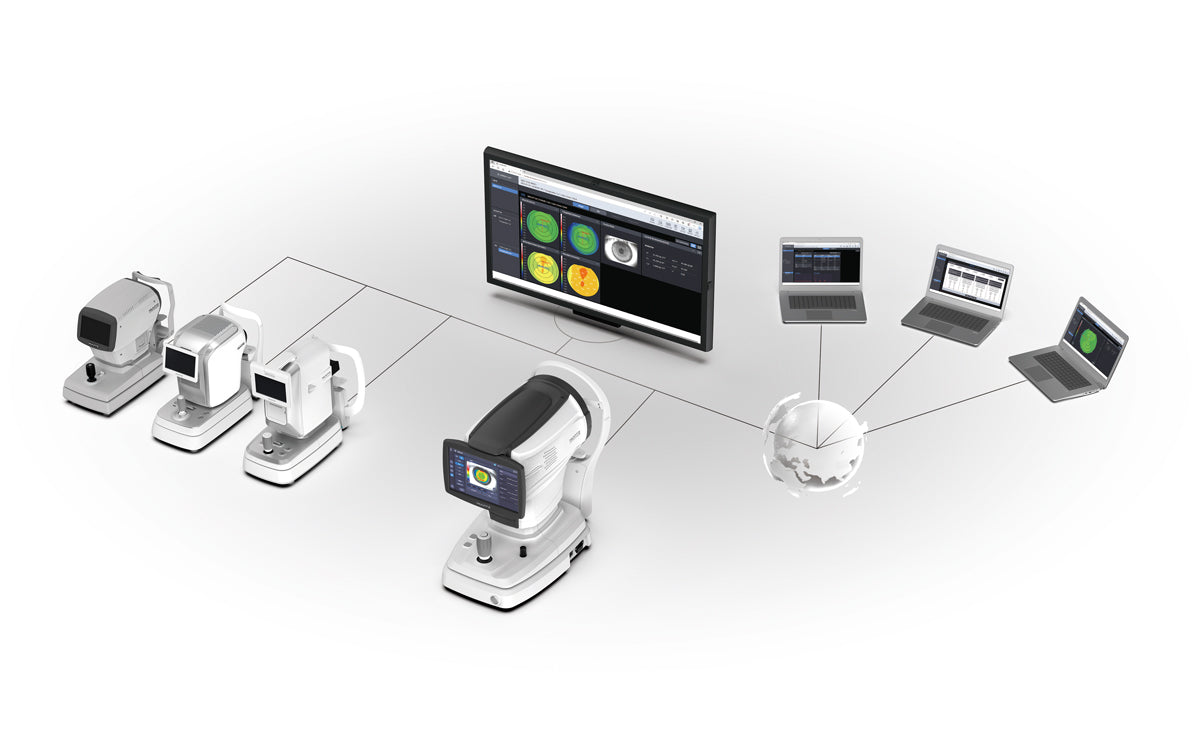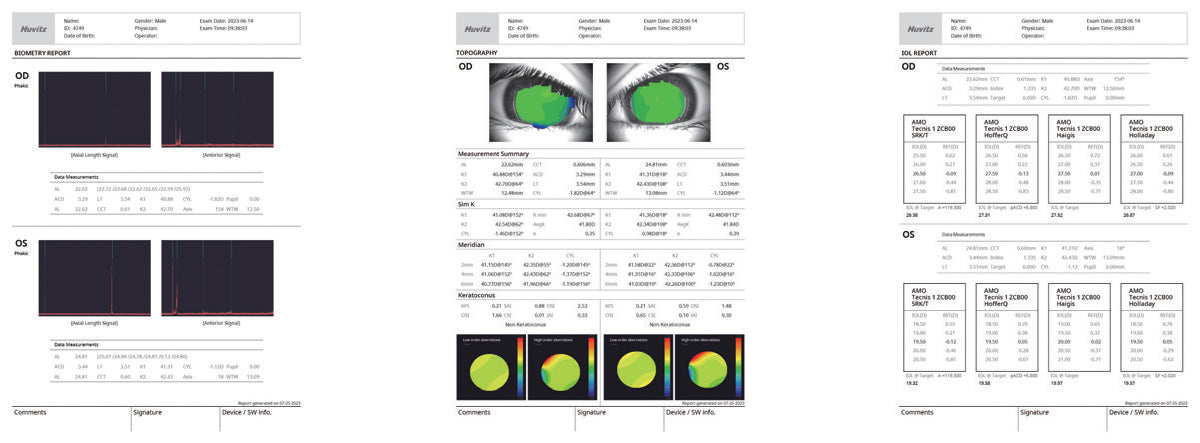Huvitz Corneal Topography HTG-1
The Huvitz Corneal Topographer HTG-1 is an advanced device designed for precise measurement and analysis of corneal topography. By optically measuring key eye components such as corneal curvature radius, corneal cylinder axis, white-to-white distance, and pupil diameter, the HTG-1 offers comprehensive insights into the cornea's structure.
Powered by Windows 10 operating system, the HTG-1 software facilitates various tests of the anterior corneal surface, providing clinicians with a comprehensive assessment tool. In addition to mapping the corneal surface, the HTG-1 offers a range of analyses to thoroughly evaluate the patient's corneal condition.
Functioning as both a corneal analyzer and topographer, the HTG-1 captures detailed images of the cornea and precisely measures its topography. Utilizing rings of the Placido reflected by an illuminated cone, the device geometrically calculates a detailed topographic map of the cornea within the image, ensuring accurate and reliable data for clinical assessment.
Our utilization of Placido disc analysis technology enables us to accurately measure a range of corneal parameters, including Keratometry, Topography, Keratoconus, Zernike Coefficients, Pupillometry, and white-to-white measurements. The resultant data is presented through Axial, Tangential, Refractive Power, and Elevation Maps. This information proves invaluable for evaluating corneal shape and health, devising vision correction lens prescriptions, and strategizing for cataract surgery.
The HTG-1 provides topography values, consistently delivering reliable data even in cases with lens opacity in cataract patients.




Through meticulous examination of the cornea's frontal curvature, regional shape, convexity, and eccentricity, our system calculates the KPI (Keratoconus Prediction Index) value to predict the likelihood of keratoconus. This invaluable information offers insights into potential risks associated with keratoconus and helps forecast potential outcomes.
Utilizing Zernike Coefficients/Map analysis, our system measures and provides analytical data for a diverse array of parameters. These include refractive power variations, irregular astigmatism, and aberrations within the eye.



Our system evaluates pupil size and responsiveness under diverse lighting conditions, encompassing both daytime and nighttime scenarios. The results of these assessments are graphically displayed, detailing parameters such as pupil diameter, maximum average pupil diameter, and average pupil diameter.


Our system facilitates the assessment of contact lens fitting with ease. It captures a fluorescein image without the need for direct injection with liquid fluorescence.



The standard format effortlessly facilitates the connection of each product to DICOM, enabling seamless integration with healthcare information systems. The measured data can then be displayed and analyzed on a personal computer (PC), ensuring efficient data management and accessibility for healthcare professionals.

The HTG-1 provides the systematic report based on the values in Topography.
Through the Auto Focus Mechanism, the HTG-1 can track the measurement point, easily and pre-cisely, quickly measuring without manual focus. The Auto Tracking guide will help you with direct-ing the Joystick and Chinrest positions.
It conveniently showcases a broad spectrum of information, including measurements and analysis reports, directly on the built-in 10.1-inch touch LCD screen, eliminating the requirement for a separate PC installation.

Click here to see the brochure

Click here to see the manual
| Corneal Topograph | |
| Working distance | 3.14 in (80 mm) |
| Placido Disc | 24 rings |
| Keratometry | ||
| Parameter | Measuring Range | Accuracy |
| Corneal measurement range |
Up to 0.38 in / 9.8 mm (R = 0.31 in / 8.0 mm, 42.2 D, n = 1.3375) |
- |
| Corneal curvature radius |
R 0.12 ~ 1.50 in (3.00 ~ 38.00 mm) (9.00 ~ 112.5 Diopter, n = 1.3375) |
0.0007 in (±0.02 mm) (± 0.1D) |
| Direction of Principal Meridians | 0° – 180° |
According to the ISO 10343:2014 R1-R2≤0.3mm: ±4° R1-R2>0.3mm: ±2° |
| The accuracy and repeatability is in accordance with Type A, ISO 19980 | ||
| White-to-white Distance | 0.27 - 0.55 in (7 – 14 mm) | 0.0019 in (±0.05 mm) |
| Pupil Diameter | 0.019 - 0.39 in (0.5 – 10 mm) | 0.0019 in (±0.05 mm) |
| Common | |
| Display | Tiltable 10.1 inch, Touch panel color LCD |
| Horizontal Movement | 1.77 in / 45 mm (back and forth), 3.93 in / 100 mm (left and right) |
| Vertical Movement | 1.18 in / 30 mm |
| Chinrest Movement | 2.44 in / 62 mm (up and down), motorized |
| Auto Tracking | X,Y for positioning, Z for working distance |
| Power Supply | AC 100 - 240 V, 50/60 Hz, 1.6 - 0.7 A |
| PC | Built in computer |
| Dimension | 11.88(W) x 19.92(D) x 20.07(H) in (302(W) x 506(D) x 510(H) mm) |
| Weight | 46.2 lb (21 kg) |
| Corneal Topograph | |
| Working distance | 3.14 in (80 mm) |
| Placido Disc | 24 rings |
| Keratometry | ||
| Parameter | Measuring Range | Accuracy |
| Corneal measurement range |
Up to 0.38 in / 9.8 mm (R = 0.31 in / 8.0 mm, 42.2 D, n = 1.3375) |
- |
| Corneal curvature radius |
R 0.12 ~ 1.50 in (3.00 ~ 38.00 mm) (9.00 ~ 112.5 Diopter, n = 1.3375) |
0.0007 in (±0.02 mm) (± 0.1D) |
| Direction of Principal Meridians | 0° – 180° |
According to the ISO 10343:2014 R1-R2≤0.3mm: ±4° R1-R2>0.3mm: ±2° |
| The accuracy and repeatability is in accordance with Type A, ISO 19980 | ||
| White-to-white Distance | 0.27 - 0.55 in (7 – 14 mm) | 0.0019 in (±0.05 mm) |
| Pupil Diameter | 0.019 - 0.39 in (0.5 – 10 mm) | 0.0019 in (±0.05 mm) |
| Common | |
| Display | Tiltable 10.1 inch, Touch panel color LCD |
| Horizontal Movement | 1.77 in / 45 mm (back and forth), 3.93 in / 100 mm (left and right) |
| Vertical Movement | 1.18 in / 30 mm |
| Chinrest Movement | 2.44 in / 62 mm (up and down), motorized |
| Auto Tracking | X,Y for positioning, Z for working distance |
| Power Supply | AC 100 - 240 V, 50/60 Hz, 1.6 - 0.7 A |
| PC | Built in computer |
| Dimension | 11.88(W) x 19.92(D) x 20.07(H) in (302(W) x 506(D) x 510(H) mm) |
| Weight | 46.2 lb (21 kg) |
NEW HTG-1, Specialized for Full Corneal Topography Analysis - US Ophthalmic














































